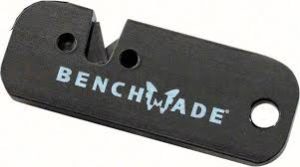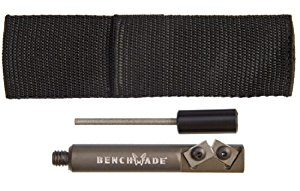Seminar Series: Edge Maintenance
#TheHuntingPages! seminar series: Knife Buying. What Characteristics do you look for when purchasing a Knife?
Posted by Hunting on Saturday, September 23, 2017
Edge
The first thing many of us do when we pick up a knife is check for sharpness. This can be done many ways. Some move their finger perpendicular across the blade, some scrape their fingernail and others try to shave hair on their arm. All of these are legitimate ways of checking sharpness. If the knife is not sharp enough many people think, “I have to sharpen my knife!”.
In the majority of cases, they actually have to hone their knife. Sharpening is a catch all term which can mean both things. The true meaning of sharpening is to removes metal to create a brand-new edge.
Honing is straightening the edge of the blade. This is what most dull blades need. A honing rod or also called a “steel” in a kitchen is a tool to straighten a blade that has dulled. At the microscopic level blade edges bend under pressure, it doesn’t mean that they always need to be “sharpened” but does mean they could be honed. This realigns the edge so that it is straight thus making it sharp again.
Hunting and Everyday Carry Knives (EDC) should be honed at least 50% of the time versus sharpened. This translates to a longer life of the blade and less actual work. A knife’s edge can be straightened by a steel in less than a minute but putting a new edge will take longer if done correctly. The challenge to honing or even putting a new edge on when it comes to hunting and EDC knives is using the correct tools that match the angle of the edge and also be a harder material than your blade steel. A great tool you can use that you find in your kitchen is the steel in your kitchen knife collection. This tool can be used for quite a few of your other knives too.
Two factors to consider when maintaining your knife edge the first is the angle of the edge the second is the hardness of the material you are using to hone or sharpen with.
Regarding blade angles Benchmade knives come from their factory in Oregon City, Oregon with a very sharp 30-35-degree angle. Because they use excellent steel, like S30V, in many of their knives and most notably in their premium Hunt Series they can hold the edge for a long time under heavy use. The act of honing straightens the edge back to its original position it does not put a new edge on it. To do that you need to sharpen which removes material from the blade to create a new one. When using a honing steel, like one found in your kitchen knife block, the blade edge is pressed with medium pressure and drawn against the honing steel at the same angle the knife was sharpened at. The most commonly used angle is 20 degrees on each side. Using even and alternating sides of the knife are worked until the edge can be felt again by your method of your choice.
The other factor is the hardness of the material you use to hone or sharpen with. Since Benchmade makes their knives from premium steel it is in you benefit to use a tool paired for it by the manufacturer. S30V steel needs a ceramic or extremely hard steel to straighten or hone blade edges made of it. Benchmade makes sharpeners that are up to the task for any knife if you buy a great sharpener it can work on knives made of less quality steel but not the other way around. The Guided Field Sharpener has ceramic, diamond, and leather in one tool that make sure your knife can be honed or sharpened and ready wherever you bring it. For even more portable options to put a new edge on is the Tactical and Mini-Tactical Pro Sharpeners have extremely hard Duromite cutters. The most portable option is the Combo Sharpener by Benchmade. This allows you to hone or sharpen you knife in the field with a honing rod and also Duromite cutters.
Sharpening can be accomplished in different ways. The craftsman or professional can work a whetstone to sharpen the edge. This is something that takes practice but is a very satisfying when accomplished. Using a sharpener like Benchmade’s Guided Field Sharpener, Combo Sharpener, or Tactical sharpeners can easily put a brand new 20-degree angle on each side with a couple swipes. The other option is a factory tune up like the Lifesharp Service by Benchmade. For the life of your Benchmade knife you can send it back postage-paid and insured and they will put a new 30-35-degree edge on and tune your knife. Benchmade offers this for all of their knives and is something to look for when purchasing a knife.
Edge maintenance is something that all knife owners need to be familiar with. There are two distinct parts of maintaining an edge. Honing which may seem a bit novel to anyone who isn’t a chef or butcher. They use a steel on their knives multiple times a day in some cases but may only sharpen once a month. The same thought process and frequency to honing your personal knives can be used on your hunt and EDC knives. The second is sharpening and should be done sparingly because it is not as necessary as most think. Sharp knives are the safest due to the reduced force needed to accomplish the task. Dull knives are the ones that end up cutting you the most so if you are going to carry a knife, keep it sharp.
visit https://www.benchmade.com/ for more information









![The Best Deer Camp Chili [VIDEO] Deer Chili Ingredients, Tomatoes, Chili Spices](/wp-content/uploads/2015/10/Deer-Chili-Deer-Camp-Recipe-218x150.jpg)








![How to Call Elk Early in the Season [VIDEO]](/wp-content/uploads/2016/08/byers003-218x150.jpg)



![Idiots Disturb Hunter: How Would You Have Handled It? [VIDEO]](/wp-content/uploads/2015/10/DSC00110-e1474487693878-100x70.jpg)
![Albino Buck Shocked to Shed His Antlers [VIDEO]](/wp-content/uploads/2015/10/AlbinoDeer-100x70.jpg)